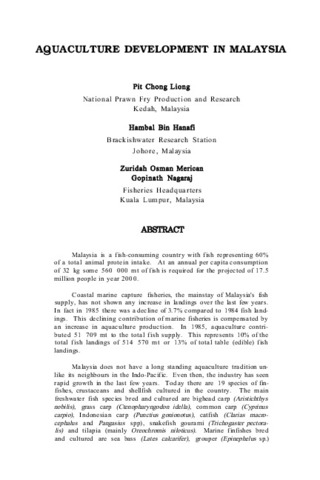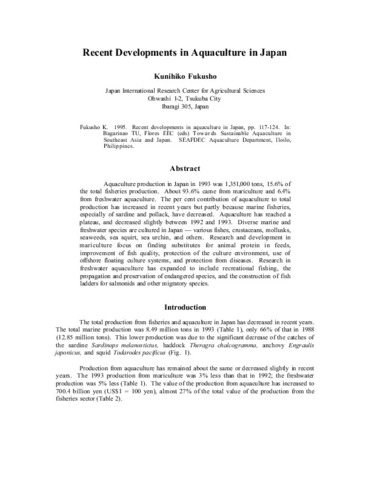The macronutrient composition of natural food organisms mass cultured as larval feed for fish and prawns
- Global styles
- MLA
- Vancouver
- Elsevier - Harvard
- APA
- Help
Share
Abstract
The macronutrient composition of natural food organisms that are mass cultured as feed for the larval stages of fish and prawns in the SEAFDEC Aquaculture Department was determined by chemical analysis. The food organisms included five species of marine phytoplanktons (algae): Chaetoceros calcitrans, Skeletonema costatum, Tetraselmis chui, Chlorella vulgaris and Isochrysis galbana, and two zooplanktons: Artemia sp. nauplii (San Francisco Bay strain) and Brachionus plicatilis. The algal species were grown in batches on Guillard and Ryther media and harvested during the exponential phase of growth using a procedure which preserved cellular integrity and prevented cell lysis. The zooplankton were cultured using standard techniques adopted at the SEAFDEC Larval Food Laboratory. Each species was analyzed for proximate composition (protein, fat, fiber and ash) and for mineral content (calcium and phosphorous). Nitrogen-free extract (NFE) was determined by difference. For the five algal species, the protein, fat and NFE contents varied from 22% to 48%, 2% to 16% and 14% to 24%, respectively. The zooplanktons had higher protein and fat contents than any of the phytoplankton species except I. galbana which had the highest fat content. On the other hand, the phytoplanktons, particularly the diatoms which have a siliceous cell wall, contained significantly higher quantities of inorganic matter (ash). C. vulgaris had the highest fiber content which may be attributed to its cellulosic cell wall.
Suggested Citation
Millamena, O. M., Peñaflorida, V. D., & Subosa, P. F. (1990). The macronutrient composition of natural food organisms mass cultured as larval feed for fish and prawns. The Israeli Journal of Aquaculture-Bamidgeh , 42(3), 77-83. http://hdl.handle.net/10862/1318
Type
ArticleISSN
0792-156XCollections
- Journal Articles [1256]
Related items
Showing items related by title, author, creator and subject.
-
Aquaculture development in Thailand
Sirikul, Boonsong; Luanprida, Somsak; Chaiyakam, Kanit; Sriprasert, Revadee (Aquaculture Department, Southeast Asian Fisheries Development Center, 1988)Aquaculture practised in Thailand is in the form of pond culture and cage culture in freshwater, brackishwater and coastal areas. The main species cultured include freshwater prawns, brackishwater shrimp, cockles, mussels, ... -
Aquaculture development in Malaysia
Liong, Pit Chong.; Hanafi, Hambal Bin.; Merican, Zuridah Osman.; Nagaraj, Gopinath. (Aquaculture Department, Southeast Asian Fisheries Development Center, 1988)Malaysia is a fish-consuming country with fish representing 60% of a total animal protein intake. At an annual per capita consumption of 32 kg some 560 000 mt of fish is required for the projected of 17.5 million people ... -
Recent developments in aquaculture in Japan
Fukusho, K. (Aquaculture Department, Southeast Asian Fisheries Development Center, 1995)Aquaculture production in Japan in 1993 was 1,351,000 tons, 15.6% of the total fisheries production. About 93.6% came from mariculture and 6.4% from freshwater aquaculture. The per cent contribution of aquaculture to total ...





